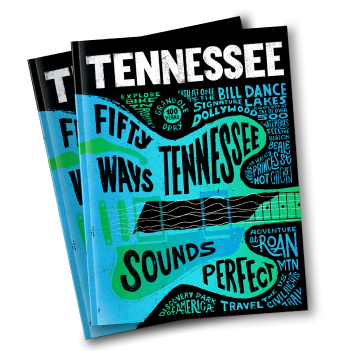Photo credit: Josh Ness of Nashville Explorer's Club
Named for the area’s history as a moonshine-running corridor, the White Lightning Trail is chock-full of history, Appalachian culture, quaint small towns, delicious Southern cuisine, and some of the most breath-taking scenery in East Tennessee. Beginning and ending in Knoxville, the trail highlights many of East Tennessee’s hidden gems.
Once known as The Marble City, Knoxville is the home of the Tennessee Valley Authority, the federal agency responsible for bringing hydroelectric power to much of the southeast during the Great Depression. Three of the agency’s man-made dams and lakes — Cherokee, Douglas and Norris — are along the trail. The history of TVA, and how it changed the lives of those living in the area — both good and bad — is told in great detail at several stops in Norris and Clinton.

Notable American frontiersmen Daniel Boone and David Crockett played important roles in American history and their respective footprints can be found along the trail. You’ll travel along the same path through the Cumberland Gap of the Appalachian Mountains as Boone did on his way to Kentucky. Cumberland Gap National Historic Park and the Daniel Boone Visitor Center are stops on the trail. Along the trail in Morristown you’ll find the restored childhood home of Tennessee native-son, David Crockett.

As the trail winds you through the breathtaking rolling hills and valleys of East Tennessee, you’ll find the quaint towns of Cumberland Gap, Dandridge, Newport, and Rocky Top. Yes, there really is a Rocky Top, Tennessee. You won’t want to miss these downtowns with their unique shopping areas, walking tours, and “mom and pop” eateries. You’ll even find legal moonshine in Newport. More on that later!
One of America’s National Scenic Byways is part of the White Lightning Trail. The East Tennessee Crossing National Scenic Byway runs from Cumberland Gap in the north to Newport in the south. The byway has been well-traveled for centuries, first as the Cherokee Warriors’ Path for Native Americans, the Wilderness Road for early settlers, Dixie Highway during the Civil War, and of course, the notorious Thunder Road by the moonshiners. Some of the best photographic scenery in East Tennessee can be found along this portion of the trail.
Pride in Appalachian history and heritage runs deep along the trail. With locations such as the Museum of Appalachia and the Appalachian Arts & Crafts Center highlighting traditional Appalachian culture, you’ll feel as if you’ve stepped back into a much earlier time. Tumultuous times are highlighted at the nearby Coal Creek Miners Museum. Coal mining has deep roots in the Appalachian Mountains, and this new museum highlights the many sacrifices made by the men and boys who entered the mines every day. As you’ll see, many never came out.


The trail takes its name from a time when illegal moonshine running was a daily occurrence and a source of income for many Appalachian families. Now that moonshine can be legally produced in Tennessee, you’re able to watch the process of making “corn-licker” at the Cocke County Copper Liquor Moonshine Distillery in Newport. Not to be outdone by ‘shine, several wineries dot the trail. Spout Spring Estate Winery in Blaine and Maynardville’s Winery at Seven Springs produce award-winning wines and offer tours and tastings.



Looking for a great local diner to satisfy your hunger? There are plenty of them to be found along the trail. Classic drive-in Cardin’s is an institution in Knoxville as is Litton’s. Old-time soda fountains can be found at Hoskins Drug Store in Clinton and Tinsley-Bible Drug Store in Dandridge. The Gigglin’ Pig in Newport offers barbecue, and traditional southern cooking is on the menu at the Davy Crockett Restaurant in Morristown.


The trail may be named for those moonshine runners of the old Thunder Road, but there’s a lot more than moonshine to be found along the trail. Grab your camera, turn off your phone and prepare for a Made in Tennessee experience along the White Lightning Trail.




























